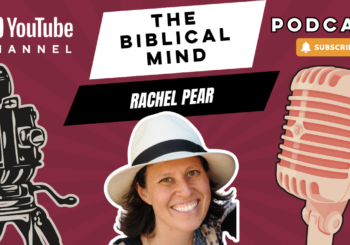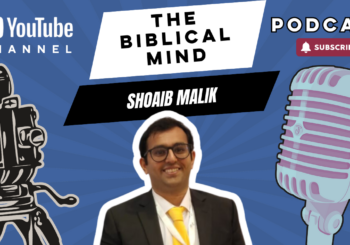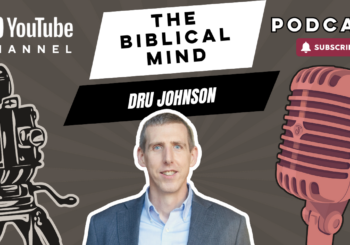How a Literary Bible Translation Transformed My View of Scripture
As a composer of sacred music, I rely on the biblical text just as deeply as a scholar or a pastor does. And the more I know about it, the better my music will be. A few months ago, I read excerpts of Robert Alter’s thrilling new Bible translation, a massive undertaking resulting from two decades of work. Its language is often startling and unexpected, always colorful, and sometimes odd, its literary style reflecting the kaleidoscopic beauty and strangeness of that ancient and holy collection of writings. His Bible translation does what I want my sacred music to do: it brings it to life—wild, teeming, glorious life. I loved it.
Enjoying this article? Read more from The Biblical Mind.
I also read Alter’s brief companion book, The Art of Bible Translation, because I wanted to know how he did it. And while the book certainly helped me understand the Scriptures in ways fruitful for my work as a composer, it also did a lot more: it gave me a new paradigm through which to experience the Bible. Thus it helped resolve some of the questions that had vexed me about it for years, such as what it means to say the Bible is “inspired,” how to understand its literary nature, and how to reconcile its sacred power with its human origins. Hence his book and Bible translation transformed how I read Scripture, which has led me to a cherish it more than ever as a source of wisdom and truth.
A Bible Translation That Sings
The springboard for this transformation was Alter’s fundamental conception about the way the biblical text works. As he writes in his introduction,
[T]he literary style of the Bible in both the prose narratives and the poetry is not some sort of aesthetic embellishment of the “message” of Scripture but the vital medium through which the biblical vision of God, human, nature, history, politics, society, and moral value is conveyed.
In essence, he argues that the Bible’s literary values—its word choice, syntax, form, and pacing, for example—are responsible not just for its expressive power, but also for much of its religious power. He demonstrates his belief using numerous case studies in which he narrates his process of Bible translation. Essentially, the process combines analysis and synthesis. Time and again he cuts into a biblical text to reveal its tendons and sinews—the oft-overlooked tissues that bind it together and make it work—and then re-animates it with a well-chosen word or phrase. The result is a Bible translation that sings where others merely speak.
Alter restores the Bible’s voice by paying careful attention to the original authors’ literary choices. To communicate the real meaning of a word, he emphasizes the need to consider the literary values of the text: the connotation of its original word, of course, but also its sonic properties, its syntax, and how it fits into the structure of the entire phrase. The resulting English rendering may involve one word, or sometimes more: whatever it takes to capture the “spirit” of the original, which is where the power of the text is to be found.
Alter is speaking my language. When I set the Bible to music, my job is to capture the connotation of the text: its mood, its “flavor,” or its affective dimension. Just like Alter, I have spent hours trying to find just the right way to communicate what I believe to be the real meaning of a word, except that I do so by choosing notes and harmonies instead of words. I need to pay attention to the word’s connotation, its position in the phrase, its dramatic function, its grammatical role, its rhythm, and of course its sound.
I know I’ve gotten it right when my musical rendering reveals the dramatic, artistic, and theological dimensions of the original text: in other words, when the music brings the text “to life.” For example, in my Holy Week piece “Tenebrae factate sunt,” I tried to capture the fear, pain, and utter desolation of Jesus during the moments of his death.
I started by establishing a dark, sinister mood by asking the choir to sing a wordless passage heavily spiked with dissonances. To set the text “There was darkness over all the earth,” I gave the altos and tenors moaning, sinewy melodies that snake around each other unpredictably. This passage calls to mind a Gregorian chant whose beauty has been warped by pain and dissonance. When the biblical author turns our attention to Jesus, I set the words “And Jesus cried out in a loud voice” using a fugue whose tumult dramatizes the anguish in his voice.
These disparate layers of the music only come together when Jesus finally cries out in utter desperation, “My God.” Yet at the moment the music suddenly pauses, and I set the Jesus’s phrase “Why hast though forsaken me?” in quiet and surprisingly consonant music. I chose these contrasting moods to illustrate Jesus’s twin natures as both man and God: the terrified cry to God coming from his human nature, and the humble, accepting second phrase revealing his understanding of God’s purpose.
Reading the Bible as Literature
By digging deep into the biblical text, Alter’s book revealed to me the depth and strength of its literary roots. And in doing so, it showed me an embarrassing truth. While I had always recognized (if vaguely) the biblical text’s literary artistry when working as a composer, I had ignored it as a reader. I had been looking for the “real” meaning of the Bible behind what seemed to be its surface decorations. At least when I was composing, I was trying to rely on the literary values I had sensed, if not understood. But as a person of faith, I had been refusing to admit the power of those same values, treating them as curtains to be swept aside in order to get a clear view of the Bible’s message. I’d been reading the Bible as if I were a mediocre translator. As a result, I never heard it sing.
Alter’s book convinced me that I needed to start reading the Bible as a piece of literature—as a work of art. Now, he will be the first to admit that the Bible’s artistic value is not always of the highest level. But that’s not the point. The fact is that many of its authors clearly approached their work as artists, and that is an approach I can understand. This realization finally gave me permission to read the Bible as a Christian in the ways that I had been approaching it as an artist.
Then the floodgates opened. Reading the Bible as if it were a work of art allowed me to embrace its difficulty, its ambiguity, its strangeness—not to fear those elements, assuming they were distracting me (or worse, leading me astray). What if I read the Bible as if it were a poem? When I read T.S. Eliot, I’m not trying to “solve” his poem, looking past its words and symbols and rhythm to find its real meaning. I let its artistry move my spirit, embrace the ways it challenges me, exult in its complex connotations, and then allow its seed to grow inside me. So why hadn’t I been reading the Bible that way? All along it had been trying to speak to me using language designed to give me what I wanted, but I had refused to hear it.
I don’t mean to suggest that just any interpretation of the Bible is correct. I’m saying that the only way to grasp its full meaning is by experiencing the result of its authors’ skill in imbuing it with the kind of depth and richness that mark literary art.
Artistry and Incarnate Authorship
When pushed, few Christians think of biblical authors as mere vessels without agency while writing under the spell of the Spirit. But by rejecting that idea of inspiration, we therefore accept that they wrote with some degree of human agency. Viewing biblical inspiration as a type of “artistic” inspiration may provide an understanding that can bridge some divides.
The crux of my argument emerges from Alter’s claim that the Bible’s artistic dimension is a key source of its spiritual and religious power. This perspective reconciles the Bible’s eternal, spiritual power with its decidedly prosaic human origins. Every time Alter points out a tiny, specific choice made by the original author, he reminds us that the author was a real, historical person. And by highlighting the artistry of that choice, he reminds us that that person was a trained professional, someone who developed literary skill over time through hard work. In other words, that author employed the full measure of his talent and training to midwife the word of God to succeeding generations.
This view of biblical inspiration allows us to sidestep some of the historical and theological battles about who the biblical authors actually were, and how that might relate to issues of authority. And since this issue has caused divisions within our faith, this view of inspiration may even help resolve disputes. If we see the artistry of the finished text as a powerful testimony of their inspiration (and therefore authority), then it becomes less important to us whether, for example, the Torah was written wholly by Moses or assembled by a raft of anonymous redactors centuries later. The breath of God is evident in the power of finished text’s literary and artistic values, no matter what the actual process was.
Highlighting the craft of textual composition allows us to recognize the deeply embodied nature of the Bible. As each author struggled to find just the right word for a passage, he undoubtedly spoke it aloud, chewing it over in his mouth and feeling it on his tongue, attending to both its semantic and its acoustic resonances. And sound is, of course, a physical phenomenon. Perhaps the Spirit helped David choose the most euphonious word as he sat alone in his palace, or maybe the Spirit opened the ears of a later editor looking for a replacement for a word that had always hampered its spiritual potential. In either case, thinking about the Bible as the result of an embodied process of artistic creation might help Christians embrace its “human-ness” without ceding any faith in its inspiration or authority.
As an artist I have seen first-hand the complex and inexplicable connections between my tiny choices and the spiritual power of my final piece. I’ve seen my music come to life in ways that transcend those choices, and that challenge my ability to understand how it happens. I’ve seen my music make people cry, and it is a very strange experience. All I did was put black marks on a piece of paper! Yet, somehow, when performed in a certain way in a certain context, those smudges and lines can become a thing of beauty that speaks to someone’s soul. Like the eucharist, music becomes sacramental when it transcends its materials, allowing us a taste of the Divine.
This is why I think Robert Alter is right. No matter how or when or where the Spirit inspired the biblical authors, the way we sense that inspiration is through the literary values of the text: those elements that bring it to life. As Christians who view the Bible as spiritual book, we need to take a cue from Alter and open ourselves to its artistic dimension. That means being willing to experience it as we do a work of art: as something that speaks in ways that transcend its created form. That requires patience, humility, and a willingness to, at times, relax our need for control and rational understanding. It means trusting that God is speaking to us in through the text even when we can’t describe how it’s happening.
Thus, Alter’s work in Bible translation is just the beginning for us. By helping us recognize and appreciate those literary values, it allows us to trust that our sense of the spiritual power of those texts is not imaginary, but fully real. In fact, through the gift of inspired artistry, that power is even more real than our world, because it points to the ultimate reality of God, our Creator, and Sustainer, and the Author of our faith.
Subscribe now to receive periodic updates from the CHT.





